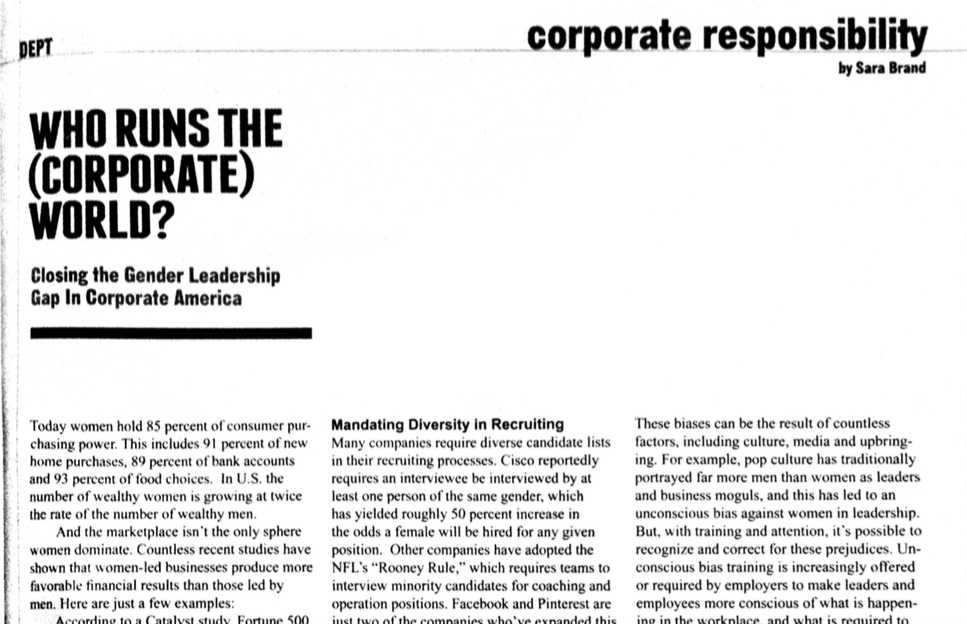This article originally appeared in Texas CEO Magazine.
Today women hold 85 percent of consumer purchasing power. This includes 91 percent of new home purchases, 89 percent of bank accounts and 93 percent of food choices. In U.S. the number of wealthy women is growing at twice the rate of the number of wealthy men.
And the marketplace isn’t the only sphere women dominate. Countless recent studies have shown that women-led businesses produce more favorable financial results than those led by men. Here are just a few examples:
According to a Catalyst study, Fortune 500 companies that have had at least three women on their board of directors for at least five years saw 84 percent higher return on sales, 60 percent higher return on invested capital and 46 percent higher return on equity, than those with no women on their boards. Recent research from Dow Jones found that successful startups have twice as many women in senior roles than unsuccessful companies, and firms with just one or more women executives are more likely to turn a profit, go public or sell at a gain. And SBA found that venture capital firms investing in women-led businesses perform better than those that invest only in businesses run by men.
So, if women have so much power in the market, and such great leadership skills, why aren’t they represented better on executive teams across Corporate America?
This is certainly not the first time this question has come up, and as the issue of gender equality in the workplace has gained traction over the last several years, there hake been a lot of positive steps towards closing the gap. Here are three great strategies leaders can implement to encourage female leadership within their organizations:
Mandating Diversity in Recruiting
Many companies require diverse candidate lists in their recruiting processes. Cisco reportedly requires an interviewee be interviewed by at least one person of the same gender, which has yielded roughly 50 percent increase in the odds a female will be hired for any given position. Other companies have adopted the NFL’s “Rooney Rule,” which requires teams to interview minority candidates for coaching and operation positions. Facebook and Pinterest are just two of the companies who’ve expanded this rule to include women, according to the Wall-Street Journal.
Developing Gender Blind Family Policies
When Mark Zuckerberg announced he’d be taking two months of leave after the birth of his first child, he stirred up the already-contentious issue of parental leave in the United States. As it stands now, women often feel pressure to choose between starting a family and starting a career, and men rarely have the option to spend more than a week or two with their newborns before returning to work. According to a Rock Health study, unequal family planning opportunities contribute to this tension, especially as the “traditional family” becomes more difficult to define. Companies like Netflix and Twitter have responded by revising their leave policies to allow more paid time off for new parents — both fathers and mothers.
Requiring Unconscious Bias Training
Unconscious bias refers to the judgments people cast — without realizing it — based on engrained assumptions about people or groups. These biases can be the result of countless factors, including culture, media and upbringing. For example, pop culture has traditionally portrayed far more men than women as leaders and business moguls, and this has led to an unconscious bias against women in leadership. But, with training and attention, it’s possible to recognize and correct for these prejudices. Unconscious bias training is increasingly offered or required by employers to make leaders and employees more conscious of what is happening in the workplace. and what is required to change the current dynamic.
Despite the staggering research in favor of women in the C-Suite, and the admirable strides many companies have made to close the gender gap, there is still much left to be done. The good news is, Texas is leading the charge. Texas ranks number two among the U.S. States for the fastest growth in the number of women-owned businesses a number that grew by 98 percent between 1997 and 2014.
What’s more, Austin ranks number six among U.S. cities for women-led businesses seeking equity funding. Although some studies show it will take approximately 100 years to reach gender parity with the current rate of progress if more companies adopt strategies like these — and follow Texas’ lead in making way for leading ladies — maybe the U.S. can close that gender gap sooner.






